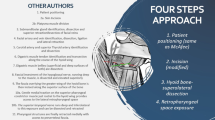Abstract
Purpose
To investigate a unique procedure of joined transoral and retropharyngeal high cervical approach (JTRC) without mandibulectomy for treating upper cervical neoplasm involving both C2 and C3.
Method
A 23-year-old male patient had neoplasma involving C2 and C3 that caused pathologic fracture of C2 and bony destruction of C3. The neoplasm excision and cervical spine reconstruction were performed through JTRC approach without splitting up the mandible. In this approach, there were two surgery windows that could be applied in turns by closing or opening the mouth to gain an ideal exposure. By rotating the mandible, we could gain maximized exposure for either surgery windows. In addition, there was an overlay zone between transoral approach and high cervical retropharyngeal approach that could eliminate the blind area behind the mandible.
Results
All the procedures were successfully performed; the surgical incisions healed without infection. By operating alternatively between the two surgery windows, we have successfully performed neoplasm excision and cervical spine reconstruction involving both C2 and C3. Pathologic results showed metastatic renal cell cancer to the resected cervical tumor and confirmed the patient’s diagnosis of tuberous sclerosis (Bourneville disease). A 3-month postoperative cervical spine radiography and CT scan demonstrated a favorable placement of the bone implant as well as a favorable instrumentation.
Conclusion
The JTRC approach could provide good surgical exposure for treating disorders involving both upper and lower cervical spine without splitting up the mandible.







Similar content being viewed by others
References
Henn JS, Lee MC, Rhoton AL (2006) Transoral approach to the craniocervical junction and upper cervical spine. In: Kim DH, Henn JS, Vaccaro AR, Dickman AC (eds) Surgical anatomy and techniques to the spine. Saunders, Philadelphia, pp 3–12
Hsu W, Wolinsky JP, Gokaslan ZL, Sciubba DM (2010) Transoral approaches to the cervical spine. Neurosurgery 66(3 Suppl):119–125
Youssef AS, Sloan AE (2010) Extended transoral approaches: surgical technique and analysis. Neurosurgery 66(3 Suppl):126–134
Molina CA, Ames CP, Chou D, Rhines LD, Hsieh PC, Zadnik PL, Wolinsky JP, Gokaslan ZL, Sciubba DM (2014) Outcomes following attempted en bloc resection of cervical chordomas in the C-1 and C-2 region versus the subaxial region: a multiinstitutional experience. J Neurosurg Spine 21(3):348–356
DeMonte F, Diaz E Jr, Callender D, Suk I (2001) Transmandibular, circumglossal, retropharyngeal approach for chordomas of the clivus and upper cervical spine: technical note. Neurosurg Focus 10(3):E10
Konya D, Ozgen S, Gerçek A, Celebiler O, Pamir MN (2008) Transmandibular approach for upper cervical pathologies: report of 2 cases and review of the literature. Turk Neurosurg 18(3):271–275 (Review)
Xia H, Yin Q, Ai F et al (2014) Treatment of basilar invagination with atlantoaxial dislocation: atlantoaxial joint distraction and fixation with transoral atlantoaxial reduction plate (TARP) without odontoidectomy. Eur Spine J 23(8):1648–1655
Goto S, Mochizuki M, Kita T, Murakami M, Nishigaki H, Moriya H (1998) Transoral joint release of the dislocated atlantoaxial joints combined with posterior reduction and fusion for a late infantile atlantoaxial rotatory fixation. A case report. Spine (Phila Pa 1976) 23(13):1485–1489
Lyons MK, Birch B (2011) Transoral surgical approach for treatment of symptomatic atlantoaxial cervical synovial cysts. Turk Neurosurg 21(4):483–488
Jiang L, Liu ZJ, Liu XG, Ma QJ, Wei F, Lv Y, Dang GT (2009) Upper cervical spine chordoma of C2–C3. Eur Spine J 18(3):293–298 (discussion 298–300)
Kansal R, Sharma A, Kukreja S (2011) An anterior high cervical retropharyngeal approach for C1–C2 intrafacetal fusion and transarticular screw insertion. J Clin Neurosci 18(12):1705–1708
Honma G, Murota K, Shiba R, Kondo H (1989) Mandible and tongue-splitting approach for giant cell tumor of axis. Spine (Phila Pa 1976) 14(11):1204–1210
Rhines LD, Fourney DR, Siadati A, Suk I, Gokaslan ZL (2005) En bloc resection of multilevel cervical chordoma with C-2 involvement. Case report and description of operative technique. J Neurosurg Spine 2(2):199–205
McDowell MM, Hanft SJ, Greenberg SA, Rahmati R, Carrao V, Eisig S, Anderson RC (2014) Resection of an upper cervical aneurysmal bone cyst and spinal reconstruction using a midline mandibular osteotomy in a pediatric patient. J Neurosurg Pediatr 13(6):622–625
Rawlins JM, Batchelor AG, Liddington MI, Towns G (2004) Tumor excision and reconstruction of the upper cervical spine: a multidisciplinary approach. Plast Reconstr Surg 114(6):1534–1538
Tan SH, Ganesan D, Rusydi WZ, Chandran H, Prepageran N, Waran V (2015) Combined endoscopic transnasal and transoral approach for extensive upper cervical osteoradionecrosis. Eur Spine J 24(12):2776–2780
Visocchi M, Di Martino A, Maugeri R, González Valcárcel I, Grasso V, Paludetti G (2015) Videoassisted anterior surgical approaches to the craniocervical junction: rationale and clinical results. Eur Spine J 24(12):2713–2723
Author information
Authors and Affiliations
Corresponding author
Ethics declarations
Conflict of interest
All the authors declare no conflict of interests.
Ethical statement
All procedures performed in studies involving human participants were in accordance with the ethical standards of the institutional and/or national research committee and with the 1964 Helsinki declaration and its later amendments or comparable ethical standards. No identifiable patient information was included in this case report. Informed consent was waived as per IRB policy on this retrospective case report. The manuscript has not been published before or is not under consideration for publication anywhere else and has been approved by all co-authors.
Rights and permissions
About this article
Cite this article
Wang, J., Lu, Y., Xia, H. et al. A unique procedure of joined transoral and retropharyngeal high cervical approach (JTRC) without mandibulectomy for treating upper cervical neoplasm involving both C2 and C3. Eur Spine J 26, 1090–1095 (2017). https://doi.org/10.1007/s00586-016-4798-4
Received:
Revised:
Accepted:
Published:
Issue Date:
DOI: https://doi.org/10.1007/s00586-016-4798-4




